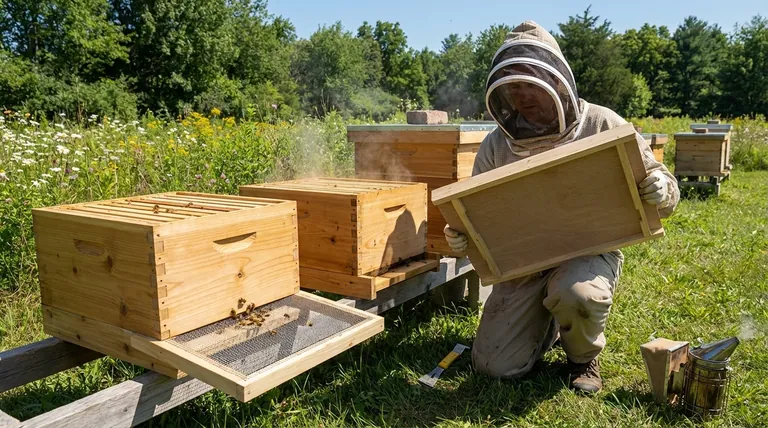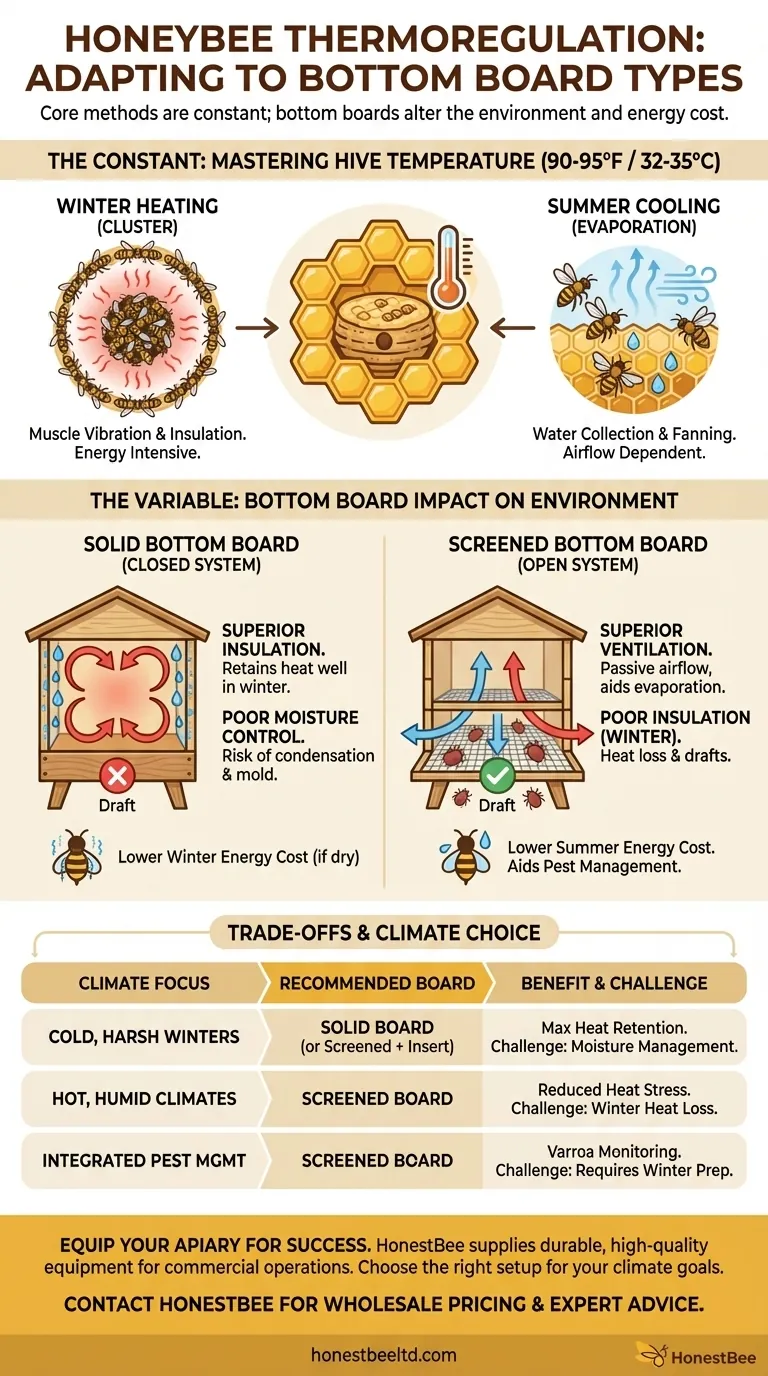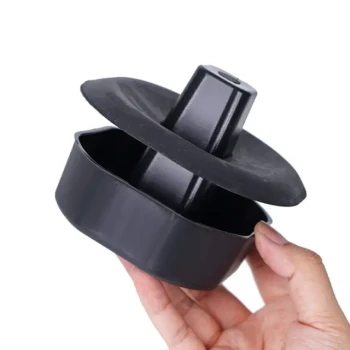At its core, a honeybee colony's method for temperature regulation does not change based on the bottom board. They use the same remarkable strategies of clustering for warmth and evaporative cooling for heat. The type of bottom board—solid or screened—simply alters the environmental conditions the bees must work against, influencing the intensity and energy cost of their efforts.
The choice between a solid and screened bottom board is not about changing the bees' behavior, but about managing the hive's ventilation and insulation. Your decision directly impacts how much energy the colony must expend to maintain its ideal internal climate.

The Constant: How Honeybees Master Thermoregulation
A honeybee colony operates as a superorganism, capable of maintaining the core brood nest at a stable 90-95°F (32-35°C) regardless of most external conditions. This is achieved through two primary, opposing strategies.
Heating: The Winter Cluster
In cold weather, honeybees form a tight cluster around their queen and brood. The bees on the outer layer of this cluster act as a living blanket of insulation.
Inside the cluster, bees generate heat by detaching their wings from their flight muscles and vibrating them rapidly. This muscular friction produces significant warmth, which is trapped by the insulating outer shell of bees.
Cooling: Fanning and Evaporation
In hot weather, the colony's priority shifts to preventing the wax comb from melting and protecting the brood from overheating. Foragers switch from collecting nectar to collecting water.
Inside the hive, worker bees spread this water over the comb and fan their wings vigorously. This creates airflow and promotes evaporation, effectively air-conditioning the hive in the same way sweat cools our skin.
The Variable: How Bottom Boards Change the Environment
While the bees' methods are constant, the bottom board fundamentally changes the physics of the hive box. It dictates the level of natural ventilation and insulation the colony has to work with.
The Solid Bottom Board: A Closed System
A solid bottom board creates an enclosed space. It offers superior insulation from the ground and prevents drafts from entering from below.
This design helps retain the heat generated by the winter cluster, potentially reducing the amount of honey the bees must consume to stay warm. However, it also traps moisture, which can be a significant problem in damp climates.
The Screened Bottom Board: An Open System
A screened bottom board, also known as an integrated pest management (IPM) board, features a hardware cloth base that leaves the hive open to the air below.
This provides constant, passive ventilation. It allows excess moisture and carbon dioxide to escape easily and greatly reduces the fanning effort required by the bees during hot weather. It also helps in monitoring and managing varroa mite populations, as mites that fall off bees will fall out of the hive.
Understanding the Trade-offs
Neither bottom board is universally superior; each presents a distinct set of advantages and challenges that the beekeeper must manage.
Challenges of a Solid Board
The primary drawback of a solid board is poor moisture control. The water vapor produced by the bees' respiration can condense on cold inner surfaces, leading to dampness and potential mold, which is detrimental to the colony's health, especially in winter. It also requires more fanning effort from the bees to cool the hive in summer.
Challenges of a Screened Board
The main concern with a screened board is heat loss during winter. The open screen allows cold air to enter from below, potentially creating a draft. The colony must consume more honey and expend more energy to generate the heat needed to compensate for this constant loss. Many beekeepers who use screened boards will add a solid insert (a "closure board") during the coldest months to mitigate this issue.
Making the Right Choice for Your Climate
Your decision should be based on your local climate and your beekeeping goals.
- If your primary focus is surviving cold, harsh winters: A solid board, or a screened board with a winter insert, is often preferred to maximize heat retention and reduce the colony's energy consumption.
- If your primary focus is managing a hot, humid climate: A screened board provides essential ventilation that reduces heat stress on the colony and minimizes the work they must do to cool the hive.
- If your primary focus is integrated pest management: A screened bottom board is a valuable tool for monitoring and reducing varroa mite populations without chemical treatments.
Ultimately, your role is to provide equipment that best supports the colony's natural ability to thrive in your specific environment.
Summary Table:
| Bottom Board Type | Key Impact on Hive Environment | Primary Benefit | Main Challenge |
|---|---|---|---|
| Solid Board | Creates a closed, insulated system. | Superior heat retention in winter. | Poor moisture control; risk of condensation. |
| Screened Board | Creates an open, ventilated system. | Excellent ventilation and varroa mite control. | Increased heat loss in winter, requiring more energy from bees. |
Ensure your apiary is equipped for success. The right bottom board is crucial for colony health and honey production. HONESTBEE supplies durable, high-quality beekeeping supplies and equipment to commercial apiaries and distributors through our wholesale-focused operations. Let us help you select the perfect equipment for your climate and management goals.
Contact HONESTBEE today for wholesale pricing and expert advice on optimizing your hive setups.
Visual Guide

Related Products
- Langstroth Solid Bottom Board for Beekeeping
- Langstroth Screen Bottom Board for Beekeeping Wholesale
- Australian Pine Wood Langstroth Screen Bottom Board for Wholesale
- HONESTBEE Professional Frame Wiring Board and Jig
- Professional Insulated Winter Hive Wrap for Beekeeping
People Also Ask
- What is the recommended approach for choosing between different types of hive boards if you have multiple hives?
- What factors should be considered when choosing between a solid and screened bottom board? Make the Right Choice for Your Hive's Health
- What are the characteristics of a solid bottom board? A Guide to Hive Foundation & Climate Control
- What is the purpose of a solid bottom board in a hive? Essential for Winter Survival & Insulation
- What is the suggested approach for choosing hive boards if you have only 1 or 2 hives? Test Both Types to Find Your Perfect Fit.



















